The Melting Point Apparatus Market is estimated to be valued at USD 27.7 billion in 2025 and is projected to reach USD 57.1 billion by 2035, registering a compound annual growth rate (CAGR) of 7.5% over the forecast period.
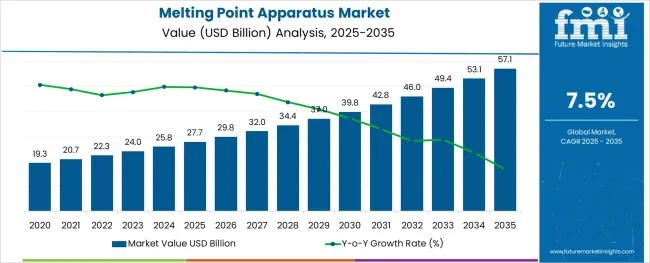
The melting point apparatus market is advancing at a steady pace as industries place greater emphasis on material characterization and quality assurance. There is an increasing need for precise melting point determination in the synthesis and testing of organic compounds and polymers. Laboratories are prioritizing automated apparatus to streamline workflows and improve repeatability in results.
Technological advancements have enhanced temperature control accuracy and ease of operation making these instruments more reliable for routine analysis. The growing demand for efficient quality control processes in pharmaceuticals and chemicals has driven adoption across research and production environments. In addition the expansion of drug discovery activities and academic research has broadened the market’s user base.
Looking ahead market expansion will likely be driven by user-friendly designs, digital data integration, and the growing need for regulatory-compliant testing tools. Segmental leadership is expected to remain with Hot Stage Apparatus in product type and Pharmaceuticals as the primary end use sector.
The market is segmented by Product Type and End Use and region. By Product Type, the market is divided into Hot Stage Apparatus, Capillary Tube, and Others. In terms of End Use, the market is classified into Pharmaceuticals, Chemical & Material, Research Laboratories, Academic Institutes, and Others. Regionally, the market is classified into North America, Latin America, Western Europe, Eastern Europe, Balkan & Baltic Countries, Russia & Belarus, Central Asia, East Asia, South Asia & Pacific, and the Middle East & Africa.
The market is segmented by Product Type and End Use and region. By Product Type, the market is divided into Hot Stage Apparatus, Capillary Tube, and Others. In terms of End Use, the market is classified into Pharmaceuticals, Chemical & Material, Research Laboratories, Academic Institutes, and Others. Regionally, the market is classified into North America, Latin America, Western Europe, Eastern Europe, Balkan & Baltic Countries, Russia & Belarus, Central Asia, East Asia, South Asia & Pacific, and the Middle East & Africa.
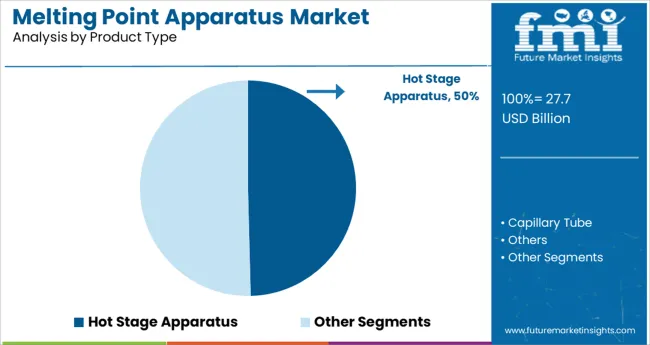
The Hot Stage Apparatus segment is projected to capture 49.6% of the melting point apparatus market revenue in 2025 establishing itself as the leading product type. This segment has grown because of the increasing preference for high-precision equipment capable of analyzing small sample quantities under controlled heating conditions.
Researchers and quality control analysts have adopted hot stage apparatus for its ability to provide detailed thermal analysis and to observe material behavior during phase transitions. Laboratories engaged in advanced material studies rely on this product type to evaluate polymorphism and purity.
The accuracy and visual confirmation provided by hot stage instruments have made them the preferred choice for complex testing applications. As laboratory protocols continue to require more sophisticated thermal analysis capabilities the Hot Stage Apparatus segment is expected to sustain its leading market position.
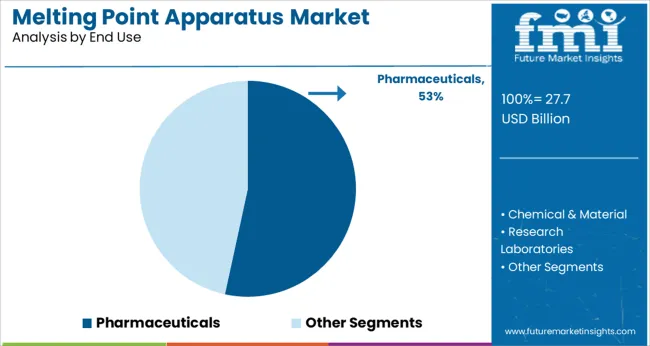
The Pharmaceuticals segment is anticipated to hold 53.4% of the melting point apparatus market revenue in 2025 remaining the most prominent end use category. This growth is driven by the pharmaceutical industry’s strict focus on purity testing and compound identification during drug formulation and manufacturing.
Regulatory guidelines have reinforced the importance of melting point determination as a standard analytical procedure in drug quality control. Research and development laboratories in pharmaceutical companies use melting point apparatus to verify raw material integrity and to support the synthesis of new active pharmaceutical ingredients.
The segment has also expanded as pharmaceutical production facilities increasingly automate their analytical testing processes to improve throughput and compliance. As global pharmaceutical production and research activities continue to grow the Pharmaceuticals segment is expected to remain the key driver of demand in the melting point apparatus market.
Increasing usage of melting point apparatus in the research and development domain for studying the characteristics and structure of some solid substances is likely to bolster growth.
The ability of these products to evaluate the purity of a substance is also expected to drive the global melting point apparatus market growth during the forthcoming years. Owing to this particular property, these are extensively used in the quality control department of a wide range of industries.
In addition to that, urgent need for drug testing to develop novel drugs for the treatment of various chronic illnesses is estimated to spur the usage of melting point apparatus in the healthcare and pharmaceutical industries. The perfume industry also utilizes melting point apparatus to produce scents having various fragrances.
Melting point apparatus can only be used to examine the melting point of various solid substances and it cannot perform any other functions. The device is mainly designed to evaluate the conversion of numerous sample substances from solid to liquid forms. Manual work is required if the sample substance undergoes deposition or sublimation.
Besides, melting point analysis cannot be done if the sample is not solid. The availability of more accurate and specific systems for qualitative identification analysis of elements may hamper the demand for melting point apparatus in the assessment period.
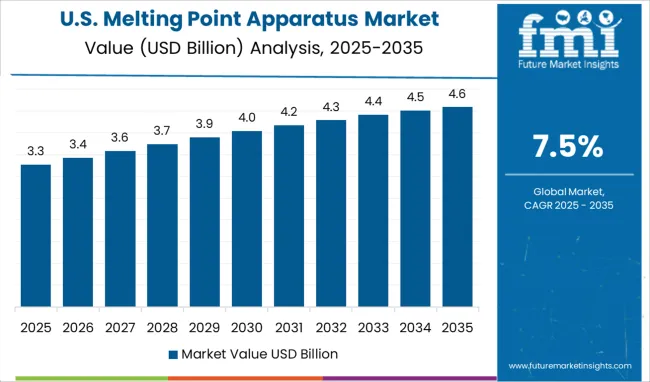
Increasing prevalence of various chronic diseases, such as heart disease, obesity, cancer, arthritis, and diabetes in the USA and Canada is projected to fuel the need for new and effective drugs. Thus, the pharmaceutical industry is investing huge sums in R&D activities, which is likely to augment the North America melting point apparatus market share in the evaluation period.
As per the Centers for Disease Control and Prevention (CDC), in 2020, about 34.1 million adults belonging to the age group of 18 years or older had diabetes in the USA, whereas 7.3 million adults aged 18 years and above did not report or were not aware of having diabetes.
The number represents 21.4% of all USA adults with diabetes and 2.8% of all adults in the country. This trend is likely to continue in the country owing to the rising consumption of junk food and adoption of a sedentary lifestyle, thereby propelling the North America market.
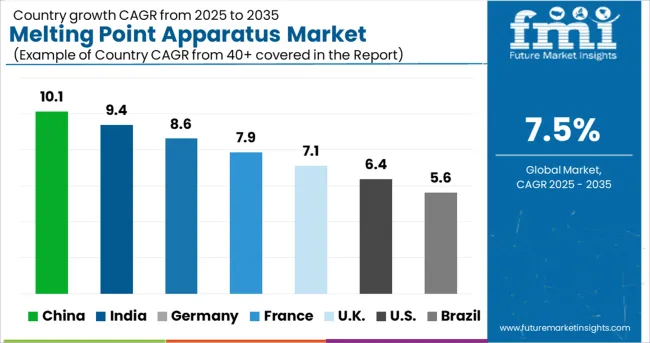
Asia Pacific is estimated to remain in the second position, followed by North America in the upcoming years. Ongoing expansion of the fragrances and perfumes industry across India, China, Malaysia, Japan, and South Korea is likely to accelerate sales of melting point apparatus for testing purposes.
Further, key players are focusing on the development of new, unique, and exciting fragrances to attract customers of various age groups in Asia Pacific. High popularity of lighter-scented products among the millennial population is another factor that would push growth. Additionally, easy availability of low-cost cologne body sprays, body mists, and body splashes in e-commerce channels is likely to augment the regional market.
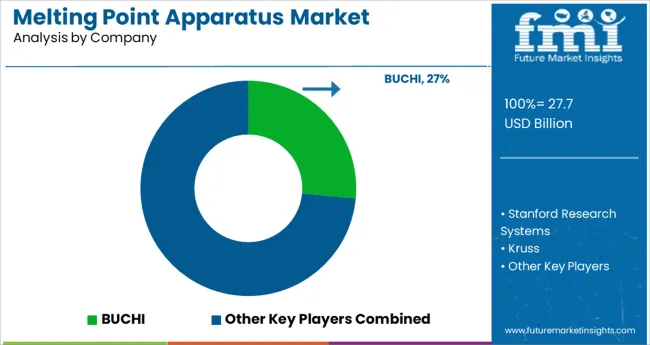
Some of the leading companies operating in the global melting point apparatus market include Shanghai Benang Instruments, Stanford Research Systems, Shanghai Instrument Physical Optics Instrument, BUCHI, Jingtuo Instruments, Jinan Hanon Instrument, Kruss, METTLER TOLEDO, AZO Materials, JiaHang Instruments, Bibby-Stuart, and Bibby-Electrmal among others.
Leading companies are mainly focusing on acquisitions and collaborations with domestic or local players. They are also striving to provide improved and technologically advanced melting point apparatus for initiating better performance. Meanwhile, some of the other key players are aiming to provide low maintenance and economical melting point apparatus to their customers. They are doing so by investing huge sums in research and development activities.
| Report Attribute | Details |
|---|---|
| Growth Rate | CAGR of 7.5% from 2025 to 2035 |
| Base Year for Estimation | 2024 |
| Historical Data | 2020 to 2024 |
| Forecast Period | 2025 to 2035 |
| Quantitative Units | Revenue in million and CAGR from 2025 to 2035 |
| Report Coverage | Revenue Forecast, Volume Forecast, Company Ranking, Competitive Landscape, Growth Factors, Trends and Pricing Analysis |
| Segments Covered | Product Type, End Use, Region
|
| Regions Covered |
North America; Latin America; Western Europe; Eastern Europe; APEJ; Japan; Middle East and Africa |
| Key Countries Profiled | USA, Canada, Brazil, Argentina, Germany, UK, France, Spain, Italy, Nordics, BENELUX, Australia & New Zealand, China, India, ASEAN, GCC, South Africa
|
| Key Companies Profiled |
Shanghai Benang Instruments; Stanford Research Systems; Shanghai Instrument Physical Optics Instrument; BUCHI; Jingtuo Instruments; Jinan Hanon Instrument; Kruss; METTLER TOLEDO; AZO Materials; JiaHang Instruments; Bibby-Stuart; Bibby-Electrmal |
| Customization | Available Upon Request |
The global melting point apparatus market is estimated to be valued at USD 27.7 billion in 2025.
It is projected to reach USD 57.1 billion by 2035.
The market is expected to grow at a 7.5% CAGR between 2025 and 2035.
The key product types are hot stage apparatus, capillary tube and others.
pharmaceuticals segment is expected to dominate with a 53.4% industry share in 2025.






Our Research Products

The "Full Research Suite" delivers actionable market intel, deep dives on markets or technologies, so clients act faster, cut risk, and unlock growth.

The Leaderboard benchmarks and ranks top vendors, classifying them as Established Leaders, Leading Challengers, or Disruptors & Challengers.

Locates where complements amplify value and substitutes erode it, forecasting net impact by horizon

We deliver granular, decision-grade intel: market sizing, 5-year forecasts, pricing, adoption, usage, revenue, and operational KPIs—plus competitor tracking, regulation, and value chains—across 60 countries broadly.

Spot the shifts before they hit your P&L. We track inflection points, adoption curves, pricing moves, and ecosystem plays to show where demand is heading, why it is changing, and what to do next across high-growth markets and disruptive tech

Real-time reads of user behavior. We track shifting priorities, perceptions of today’s and next-gen services, and provider experience, then pace how fast tech moves from trial to adoption, blending buyer, consumer, and channel inputs with social signals (#WhySwitch, #UX).

Partner with our analyst team to build a custom report designed around your business priorities. From analysing market trends to assessing competitors or crafting bespoke datasets, we tailor insights to your needs.
Supplier Intelligence
Discovery & Profiling
Capacity & Footprint
Performance & Risk
Compliance & Governance
Commercial Readiness
Who Supplies Whom
Scorecards & Shortlists
Playbooks & Docs
Category Intelligence
Definition & Scope
Demand & Use Cases
Cost Drivers
Market Structure
Supply Chain Map
Trade & Policy
Operating Norms
Deliverables
Buyer Intelligence
Account Basics
Spend & Scope
Procurement Model
Vendor Requirements
Terms & Policies
Entry Strategy
Pain Points & Triggers
Outputs
Pricing Analysis
Benchmarks
Trends
Should-Cost
Indexation
Landed Cost
Commercial Terms
Deliverables
Brand Analysis
Positioning & Value Prop
Share & Presence
Customer Evidence
Go-to-Market
Digital & Reputation
Compliance & Trust
KPIs & Gaps
Outputs
Full Research Suite comprises of:
Market outlook & trends analysis
Interviews & case studies
Strategic recommendations
Vendor profiles & capabilities analysis
5-year forecasts
8 regions and 60+ country-level data splits
Market segment data splits
12 months of continuous data updates
DELIVERED AS:
PDF EXCEL ONLINE
Dew Point Apparatus Market Size and Share Forecast Outlook 2025 to 2035
Flash Point Apparatus Market
Point-of-Care Fentanyl Test Kits Market Size and Share Forecast Outlook 2025 to 2035
Point-of-Care Opioid Testing Market Size and Share Forecast Outlook 2025 to 2035
Point-of-Care Food Sensitivity Testing Market Size and Share Forecast Outlook 2025 to 2035
Point-of-Care Diagnostics Market Size and Share Forecast Outlook 2025 to 2035
Point-Of-Care Breathalyzer Market Size and Share Forecast Outlook 2025 to 2035
Point Of Care Blood Testing Devices Market Size and Share Forecast Outlook 2025 to 2035
Point-of-care Cholesterol Monitoring Device Market Size and Share Forecast Outlook 2025 to 2035
Point-to-point Microwave Antenna Market Analysis by Polarization, Antenna Type, Diameter, Frequency Range and Region Through 2035
Point-of-care Molecular Diagnostics Market Insights – Trends & Growth 2025 to 2035
Point of Sale (PoS) Printers Market Insights – Growth & Forecast through 2034
Point Of Care Infection Control Market
Point-Of-Use Disposable Bag Testing Market
Point Of Care CT Imaging Market
Point-Of-Care Genetic Testing Market
Endpoint Detection and Response Market Growth - 2025 to 2035
Endpoint Protection Platform Market Growth – Trends & Forecast 2025-2035
Endpoint Security Solutions Market
Dew Point Thermometer Market

Thank you!
You will receive an email from our Business Development Manager. Please be sure to check your SPAM/JUNK folder too.
Chat With
MaRIA